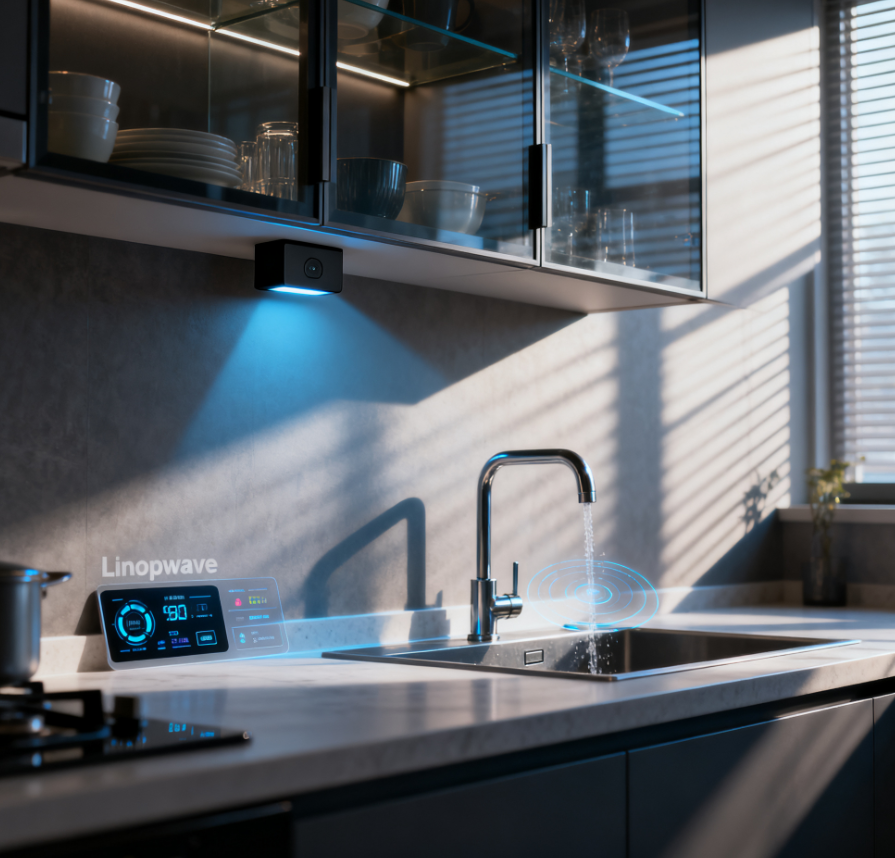In modern smart homes, the quality and sensitivity of presence sensors directly impact user experience. Traditional motion sensors often fail to detect subtle movements, such as a person sitting quietly or breathing, which can result in lights turning off unexpectedly, HVAC systems misfiring, or home security features triggering unnecessarily. Linpowave mmWave radar presence sensors address these challenges by providing precise detection of even the tiniest micro-movements, ensuring seamless automation across different environments.
Micro-Movement Detection for Accurate Automation
A key concern for smart home users is whether a sensor can detect minor human movements. Linpowave mmWave radar sensors can sense subtle motions, such as slight shifts in posture or breathing, allowing smart devices to respond accurately even when occupants remain mostly still. This capability is essential for applications like room occupancy detection, automated lighting adjustments, or pausing entertainment systems when rooms are empty. By focusing on micro-movement detection, these sensors improve reliability and reduce false triggers, which is a common pain point with older presence sensors.
Noise Filtering and Interference Management
Environmental interference is another significant challenge. Fans, heaters, air purifiers, and even certain household appliances can disrupt sensor readings. Linpowave sensors utilize advanced radar signal processing to distinguish between relevant human movements and environmental noise. Users can further customize detection thresholds and define exclusion zones to filter out unwanted activity. This ensures that the sensor remains accurate without triggering unnecessary actions, providing peace of mind in homes with multiple electronic devices or areas prone to air currents.
Flexible Installation and Power Options
Customers often struggle with installation constraints and power requirements. Linpowave sensors support multiple power configurations, including Power over Ethernet (PoE), USB, and battery operation. PoE enables reliable 24/7 operation, making it ideal for critical security systems or high-traffic areas, while USB or battery power allows for quick and flexible installation in less critical zones. The compact design enables installation on walls, ceilings, or corners, minimizing visible wiring and preserving the aesthetics of modern interiors. The flexibility in installation reduces the complexity often faced by homeowners and system integrators.
Multi-Zone Detection and Heatmap Visualization
For larger homes or multi-room setups, the ability to detect occupancy in multiple zones is crucial. Linpowave sensors support multi-zone detection, enabling precise automation based on room-specific occupancy. Heatmap visualization allows homeowners or facility managers to analyze movement patterns, identify underused spaces, and adjust automation rules accordingly. This functionality not only increases comfort and convenience but also helps optimize energy usage by activating devices only where and when needed.
Compatibility and Network Stability
Compatibility with smart home platforms is a critical factor for many users. Linpowave sensors integrate seamlessly with popular automation systems, allowing devices to work together without additional adapters or complex configuration. Unlike some Wi-Fi-based sensors, which may drop connections in mesh networks or during channel switching, PoE-powered mmWave sensors maintain high network stability. This guarantees continuous and reliable performance for both residential and commercial smart home applications, addressing a common frustration with intermittent connectivity.
Firmware Updates and Customization
Modern users expect their devices to evolve over time. Linpowave sensors support over-the-air (OTA) firmware updates, enabling new features and security improvements without requiring physical intervention. Additionally, users can customize detection zones, thresholds, and sensitivity levels, tailoring the sensor to specific use cases. This level of flexibility ensures that the system can adapt to changing home layouts or user preferences, providing long-term value and satisfaction.
Cost Efficiency and Support
While cost is always a consideration, customers seek value rather than simply the lowest price. Linpowave sensors deliver advanced detection technology at competitive prices, balancing affordability with high performance. Transparent pricing, clear shipping policies, and responsive customer support help users make confident purchasing decisions. Detailed technical documentation and expert guidance ensure that users can maximize the sensor’s capabilities, reducing trial-and-error installation and ongoing maintenance costs.
User-Friendly Design and Long-Term Reliability
Finally, user experience is paramount. Linpowave sensors are designed for intuitive installation and operation, requiring minimal setup. Durable construction guarantees consistent performance over years, reducing maintenance requirements and providing reliable service even in high-traffic or complex environments. The combination of sensitivity, stability, and ease of use ensures that homeowners enjoy smart automation without frustration or frequent adjustments.
Frequently Asked Questions (FAQ)
Q1: How do Linpowave sensors detect micro-movements?
They use mmWave radar to sense subtle human motions, including breathing, posture shifts, and hand gestures, enabling precise presence detection.
Q2: Can Linpowave sensors detect through glass partitions?
Yes. The mmWave technology penetrates non-metallic materials such as glass or plastic, eliminating blind spots in partitioned areas.
Q3: What power options are available?
PoE, USB, and battery configurations are available, allowing flexible deployment for different installation scenarios.
Q4: Are Linpowave sensors compatible with smart home systems?
Yes. They integrate with a wide range of platforms, ensuring smooth operation and reliable automation.
Q5: How can I optimize sensor performance?
Optimal sensor placement, multi-zone configuration, and regular firmware updates help maintain high accuracy.
For more details on integrating mmWave radar into smart homes, visit Linpowave Smart Home Radar Solutions.
Explore Linpowave’s product range here: V10 In-Cabin mmWave Radar Sensor



